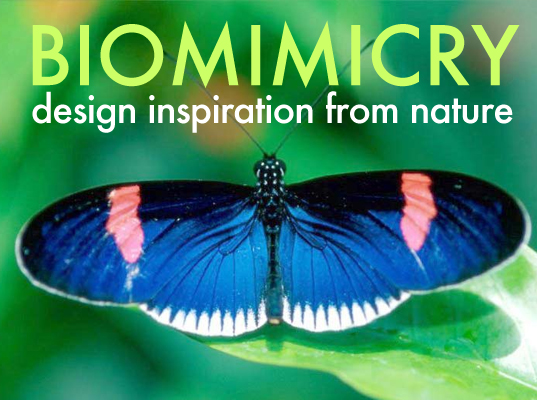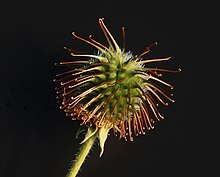 Biomimicry or biomimetics is the examination of nature, its models, systems, processes, and elements to emulate or take inspiration from in order to solve human problems. The term biomimicry and biomimetics come from the Greek words bios, meaning life, and mimesis, meaning to imitate. Other terms often used are bionics, bio-inspiration, and biognosis.
Biomimicry or biomimetics is the examination of nature, its models, systems, processes, and elements to emulate or take inspiration from in order to solve human problems. The term biomimicry and biomimetics come from the Greek words bios, meaning life, and mimesis, meaning to imitate. Other terms often used are bionics, bio-inspiration, and biognosis.
History
Humans have always looked to nature for inspiration to solve problems. One of the early examples of biomimicry was the study of birds to enable human flight. Although never successful in creating a "flying machine", Leonardo da Vinci (1452–1519) was a keen observer of the anatomy and flight of birds, and made numerous notes and sketches on his observations as well as sketches of various "flying machines".[1] The Wright Brothers, who finally did succeed in creating and flying the first airplane in 1903, also derived inspiration for their airplane from observations of pigeons in flight.[2]
Here is a short video (in French with flemish subtitles for now, english version coming soon!)
Otto Schmitt, an American academic and inventor, coined the term biomimetics to describe the transfer of ideas from biology to technology. The term biomimetics only entered the Websters Dictionary in 1974 and is defined as "the study of the formation, structure, or function of biologically produced substances and materials (as enzymes or silk) and biological mechanisms and processes (as protein synthesis or photosynthesis) especially for the purpose of synthesizing similar products by artificial mechanisms which mimic natural ones".
 In 1960, the term bionics was coined by psychiatrist and engineer Jack Steele to mean "the science of systems which have some function copied from nature".[3] Bionics entered the Webster dictionary in 1960 as "a science concerned with the application of data about the functioning of biological systems to the solution of engineering problems". The term bionic took on a different connotation when Martin Caidin referenced Jack Steele and his work in the novel "Cyborg" which later resulted in the 1974 television series "The Six Million Dollar Man" and its spin-offs. The term bionic then became associated with 'the use of electronically-operated artificial body parts' and 'having ordinary human powers increased by or as if by the aid of such devices'.[4] Because the term bionic took on the implication of super natural strength, the scientific community in English speaking countries shied away from using it in subsequent years.[5]
In 1960, the term bionics was coined by psychiatrist and engineer Jack Steele to mean "the science of systems which have some function copied from nature".[3] Bionics entered the Webster dictionary in 1960 as "a science concerned with the application of data about the functioning of biological systems to the solution of engineering problems". The term bionic took on a different connotation when Martin Caidin referenced Jack Steele and his work in the novel "Cyborg" which later resulted in the 1974 television series "The Six Million Dollar Man" and its spin-offs. The term bionic then became associated with 'the use of electronically-operated artificial body parts' and 'having ordinary human powers increased by or as if by the aid of such devices'.[4] Because the term bionic took on the implication of super natural strength, the scientific community in English speaking countries shied away from using it in subsequent years.[5]
The term biomimicry appeared as early as 1982.[6] The term biomimicry was popularized by scientist and author Janine Benyus in her 1997 book Biomimicry: Innovation Inspired by Nature. Biomimicry is defined in her book as a "new science that studies nature's models and then imitates or takes inspiration from these designs and processes to solve human problems". Benyus suggests looking to Nature as a "Model, Measure, and Mentor" and emphasizes sustainability as an objective of biomimicry.[7]
Examples
Researchers, for example, studied the termite's ability to maintain virtually constant temperature and humidity in their termite mounds in Africa despite outside temperatures that vary from 1.5 °C to 40 °C (35 °F to 104 °F). Researchers initially scanned a termite mound and created 3-D images of the mound structure, which revealed construction that can influence human building design. The Eastgate Centre, a mid-rise office complex in Harare, Zimbabwe, (highlighted in this Biomimicry Institute case-study) stays cool without air conditioning and uses only 10% of the energy of a conventional building its size.
Modeling echolocation in bats in darkness has led to a cane for the visually impaired. Research at the University of Leeds, in the United Kingdom, led to the UltraCane, a product formerly manufactured, marketed and sold by Sound Foresight Ltd.
Janine Benyus refers in her books to spiders that create web silk as strong as the Kevlar used in bulletproof vests. Engineers could use such a material—if it had a long enough rate of decay—for parachute lines, suspension bridge cables, artificial ligaments for medicine, and many other purposes.[7]
Other research has proposed adhesive glue from mussels, solar cells made like leaves, fabric that emulates shark skin, harvesting water from fog like a beetle, and more. Nature’s 100 Best is a compilation of the top hundred different innovations of animals, plants, and other organisms that have been researched and studied by the Biomimicry Institute.
A display technology based on the reflective properties of certain morpho butterflies was commercialized by Qualcomm in 2007. The technology uses Interferometric Modulation to reflect light so only the desired color is visible to the eye in each individual pixel of the display.
Biomimicry may also provide design methodologies and techniques to optimize engineering products and systems. An example is the re-derivation of Murray's law, which in conventional form determined the optimum diameter of blood vessels, to provide simple equations for the pipe or tube diameter which gives a minimum mass engineering system.[8]
A novel engineering application of biomimetics is in the field of structural engineering. Recently, researchers from Swiss Federal Institute of Technology (EPFL) have been incorporating biomimetic characteristics in an adaptive deployable tensegrity bridge [1]. The bridge can carry out self-diagnosis and self-repair utilizing a machine learning algorithm.
References
- ^ Romei, Francesca (2008). Leonardo Da Vinci. The Oliver Press. p. 56. ISBN 978-1934545003.
- ^ Howard, Fred (1998). Wilbur and Orville: A Biography of the Wright Brothers. Dober Publications. p. 33. ISBN 978-0486402970.
- ^ .
- ^ Compact Oxford English Dictionary. 2008. ISBN 978-0-19-953296-4.
- ^ Vincent, JFV (2009). "Biomimicry-a review". Proc. I. Mech. E. 223: p919-939.
- ^ Merrill, Connie Lange (1982). Biomimicry of the Dioxygen Active Site in the Copper Proteins Hemocyanin and Cytochrome Oxidase. Rice University.
- ^ a b Benyus, Janine (1997). Biomimicry: Innovation Inspired by Nature. New York, NY, USA: William Morrow & Company, Inc.. ISBN 978-0688160999.
- ^ Williams, Hugo R.; Trask, Richard S., Weaver, Paul M. and Bond, Ian P. (2008). "Minimum mass vascular networks in multifunctional materials". Journal of the Royal Society Interface 5 (18): 55–65. doi:10.1098/rsif.2007.1022. PMID 17426011. PMC 2605499. http://rsif.royalsocietypublishing.org/content/5/18/55.full.
Videos
- Janine Benyus: Biomimicry in Action from TED 2009
- Janine Benyus: 12 sustainable design ideas from nature from TED 2005
- Robert Full shows how human engineers can learn from animals' tricks from TED 2002
- Sex, Velcro and Biomimicry with Janine Benyus
- The Fast Draw: Biomimicry from CBS News
External links
- Termite Mounds Inspire Zimbabwe Office Complex
- Biomimetic Architecture - Biomimicry applied to building and construction
Further reading
- Thompson, D W., On Growth and Form. Dover 1992 reprint of 1942 2nd ed. (1st ed., 1917).
- Vogel, S., Cats' Paws and Catapults: Mechanical Worlds of Nature and People. Norton & co. 2000.
- Benyus, J. M. (2001). Along Came a Spider. Sierra, 86(4), 46-47.
- Hargroves, K. D. & Smith, M. H. (2006). Innovation inspired by nature Biomimicry. Ecos, (129), 27-28.
- Pyper, W. (2006). Emulating nature: The rise of industrial ecology. Ecos, (129), 22-26.
- Smith, J. (2007). It’s only natural. The Ecologist, 37(8), 52-55.
- Passino, Kevin M. (2004). Biomimicry for Optimization, Control, and Automation. Springer
- Rinaldi, Andrea (2007). "Naturally better. Science and technology are looking to nature's successful designs for inspiration". European Molecular Biology Organization 8 (11): 995–999. doi:10.1038/sj.embor.7401107. http://www.ncbi.nlm.nih.gov/pmc/articles/PMC2247388/.
See also
- Bioinspiration & Biomimetics (peer-reviewed journal)
- Bionics
- Bright green environmentalism
- EcoCover
- Mercedes-Benz Bionic concept car.
- Mimicry
- Permaculture
- The Water Cube
- Technogaianism
- Tristram Carfrae

